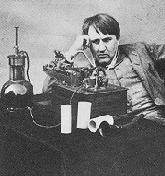 |
||
|
MAN OF THE CENTURY | ||
|
"Genius is one percent inspiration and 99 percent perspiration." Thomas A. Edison "Without Edison, there would be 0 percent Internet." Joel Leyden
After Thomas Edison moved to the Menlo Park Laboratory in New Jersey, USA, he promised he would turn out a minor invention every 10 days and a "big trick" every six months. Edison and his staff were working on as many as 40 projects at one time and he was applying for nearly 400 patents each year during this time. Thomas Edison employed many people at his laboratories and Edison Manufacturing Company. Under his direction they handled the bulk of the design, research and experimentation on the projects. Ultimately Edison took complete credit for everything made within his company and most if not all patents were applied for under his name. All told, Thomas Edison received patents for 1093 inventions, as either sole inventor or co-inventor. He received 389 for electric light and power, 195 for the phonograph, 150 for the telegraph, 141 for storage batteries, and 34 for the telephone. These are just a few of the 1093 patents issued to inventions of Thomas Alva Edison.
Holder for Article to be Electroplated 1933 (Patent # 1,908,830) Last patent granted to Thomas Edison, 2 years after his death. Biography of Thomas Alva Edison
Born in Milan Ohio, February 11, 1847 to Samuel Edison, Jr and Nancy Elliot; Thomas was the last of seven children. His middle name "Alva" was given in honor of Captain Alva Bradley who operated a fleet of ships on Lake Erie. Thomas Edison's siblings were Marion, William, Callie, Harriet, Samuel and Eliza.The Edison family moved to Port Huron, Michigan in 1854 where Samuel Edison took a job as carpenter. Samuel Edison went on to be a land speculator and owner of a lumber business. At school in Port Huron Thomas Edison was not considered a bright student. His hearing problems caused him difficulty with his lessons and his attendance was sporadic at best. At 10 years of age Nancy Edison removed Thomas from school and began teaching him herself. She gave Edison books to read. He became most interested in books on chemistry and was allowed to set up a laboratory in his family's home, which his mother made him move to the basement because of the mess. Two years later Thomas moved his laboratory to an empty railcar on the Grand Trunk Railway where he was given a job as trainboy. He also printed a weekly newspaper he called the Grand Trunk Herald. Aledgedly while working on the railway Edison saved the life of a station official's child who had fallen onto the tracks of an oncoming train. As a way of thanking Edison for saving the child's life, the father taught Thomas how to use the telegraph. Over the years Edison became so proficient with the telegraph he served as a telegrapher from the southern United States to Canada. He started work on improving the telegraph which led to his invention of the automatic telegraph, duplex telegraph and message printer. These inventions led Edison to begin a new career of fulltime inventor. Thomas Edison moved to New York and setup a small laboratory in Newark New Jersey. He continued his work on the telegraph and his ideas gave birth to the Universal Stock Printer. In 1871 he married his first wife Mary Stilwell. Mary was 16 at the time and 9 years younger than Thomas. Mary was working in Edison's labratory when the two met. Thomas and Mary had three children: Marion, Thomas Jr. and Wiliam. In 1875 Edison asked Mary's father to help him build a new laboratory in Menlo Park. He brought in his father Samuel from Port Huron to supervise the construction of the new laboratory which opened in 1876. Here is where Edison invented the carbon-button transmitter, and the cylinder phonograph. With the help and backing of J. P. Morgan and others, Edison opened the Edison Electric Company. In 1879 Thomas Edison unveiled his incandescent light bulb. As the 1880's began Edison planned and supervised the construction of the first commercial, central power system in lower Manhattan. In 1883 an engineer in Edison's laboratory made a discovery which eventually led to the electron tube. This discovery was patented as "The Edison Effect". In 1884 Edison's wife Mary died, two years later he married Mina Miller. Thomas and Mina had three children: Madeline, Charles and Theodore. He then began construction of a new laboratory in West Orange New Jersey, and also made plans to build a winter home and laboratory in Florida. The Edison phonograph, the kinetoscope, storage battery, electric pen, mimeograph and many other new inventions sprang to life from Edison's idea's, sometimes by plan, other times quite simply by accident. In his life Thomas Edison patented 1093 of his inventions. He died at his West Orange, New Jersey home on October 18, 1931. Thomas Edison was buried behind his "Glenmont" home which is now a museum operated by the National Park Service. Mina Edison was buried next to Thomas after her death. |
||

